| Article ID | Journal | Published Year | Pages | File Type |
|---|---|---|---|---|
| 10693218 | Ultrasound in Medicine & Biology | 2005 | 13 Pages |
Abstract
Ultrasonic temperature imaging is a promising technique for guiding focused ultrasound surgery (FUS). The FUS system is run at an initial, nonablative intensity and a diagnostic transducer images the heat-induced echo strain, which is proportional to the temperature rise. The echo strain image portrays an elliptical “hot spot” corresponding to the focal region of the therapy transducer. It is anticipated that such images will be used to predict the location of the thermal lesion that would be produced at an ablative intensity. We demonstrated in vitro that heat-induced echo strain images can visualize a spatial peak temperature rise of <2°C (starting at room temperature). However, the imaging beam was perpendicular to the treatment beam in these experiments, whereas the most convenient approach in vivo would be to mount the imaging probe within the housing of the therapy transducer such that the two beams are coaxial. A previous simulation experiment predicted that echo strain images would be noisier for the coaxial configuration because sharp lateral gradients in axial displacement cause increased RF signal decorrelation within the beam width. The aim of the current study was to verify this prediction in vitro. We found, that for a temperature rise of â¼4°C, the mean contrast-to-noise ratio for coaxial and perpendicular echo strain images was 0.37 (±0.24) and 2.00 (±0.72) respectively. Furthermore, the decorrelation noise seen in the coaxial images obscured the posterior axial border of the hot spot. We conclude that the coaxial configuration will be useful for localizing the hot spot in the lateral direction. However, it may not be able to depict the axial extent of the hot spot or to portray a parameter that is directly related to temperature rise. (E-mail: Naomi.Miller@icr.ac.uk)
Related Topics
Physical Sciences and Engineering
Physics and Astronomy
Acoustics and Ultrasonics
Authors
Naomi R. Miller, Konstantin M. Bograchev, Jeffrey C. Bamber,
